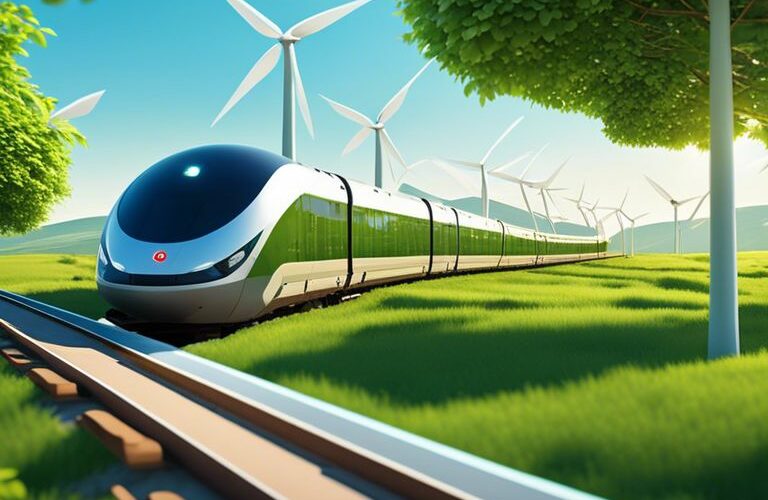Amidst the growing concerns of climate change, it is imperative to recognize the crucial role that railways play in combating this global issue. While the environmental impact of transportation continues to be a significant challenge, railways offer a sustainable and eco-friendly mode of travel and transportation. By delving into the positive impact of trains on climate change, we can gain a deeper understanding of how this mode of transportation can contribute to a more sustainable future.
Table of Contents
The Role of Trains in Modern Transportation
To understand the significant role trains play in modern transportation, we must delve into their historical significance and the current global rail infrastructure. Trains have been an integral part of our transportation system for centuries, and their impact continues to be felt in the modern world. From the historical perspective to the current global perspective, rail transport has played a vital role in shaping our transportation landscape.
Historical Overview of Rail Transport
With the advent of the steam engine in the early 19th century, there was a significant shift in transportation. Trains emerged as a powerful and efficient mode of travel and freight transportation. The development of rail transport revolutionized the movement of goods and people, leading to significant advancements in industrialization and connectivity.
During the 20th century, trains continued to play a pivotal role in shaping the transportation infrastructure of nations, leading to the establishment of extensive rail networks across continents. This historical overview showcases the transformative impact of trains on transportation and their enduring relevance in modern times.
Current Global Rail Infrastructure
Infrastructure plays a crucial role in supporting the current global rail network, which spans vast distances and connects diverse regions. Rail infrastructure is the foundation of modern transportation networks, enabling efficient movement of passengers and goods across urban centers and rural areas. The current global rail infrastructure encompasses high-speed rail systems, freight corridors, and urban metro networks, contributing to sustainable and efficient transportation solutions.
Trains continue to be a environmentally friendly option for transportation, with a significantly lower carbon footprint compared to other modes of transport. They have become a critical component of climate-conscious transportation strategies and are positioned to play a key role in mitigating the impacts of climate change on the environment.
Trains and Environmental Sustainability
Some of the greatest challenges facing our planet today are related to climate change and environmental sustainability. As the world seeks alternative modes of transportation that are less harmful to the environment, the role of railways in promoting sustainability has become increasingly important.
Energy Efficiency of Rail Transport
Any discussion of the environmental benefits of trains must begin with their exceptional energy efficiency. Trains are known to be one of the most energy-efficient modes of transportation, requiring less fuel per tonne of freight or passenger mile compared to other forms of transport like cars, trucks, or airplanes. The electric trains, in particular, are highly efficient as they can utilize regenerative braking technology to recapture energy during braking, further enhancing their efficiency.
Furthermore, it is important to note that electric trains have the added advantage of being able to draw power from a grid that can be increasingly fueled by clean, renewable energy sources, making them even more sustainable in the long run.
Reduction in Greenhouse Gas Emissions
Emissions from transportation are a major contributor to greenhouse gas emissions, which are a leading cause of climate change. The use of trains contributes significantly to the reduction of greenhouse gas emissions, particularly when compared to other modes of transportation that rely heavily on fossil fuels. The efficient use of energy and the ability to use electricity from renewable sources mean that trains play a vital role in reducing the carbon footprint of the transportation sector.
Sustainability is at the forefront of this reduction, as the implications of decreased greenhouse gas emissions and improved air quality have significant positive effects on the overall health of our planet.
The Impact on Air Quality
Impact on Air Quality
This impact is particularly noticeable in urban areas, where air pollution from transportation is a major concern. Trains, especially electric ones, produce zero direct emissions at the point of use, leading to improved air quality and public health. In fact, the reduction in air pollutants such as nitrogen oxide and particulate matter has substantial positive effects on the environment and the health of people living in and around urban areas.
Integration with Renewable Energy Sources
Quality
Plus
Advances in Train Technology
Your journey on the railway is not just a mode of transportation but a peek into the future of sustainable travel. Advances in train technology have led to significant improvements in efficiency, speed, and environmental impact. Let’s take a closer look at the key areas where innovation in train technology is paving the way for a greener and more sustainable future.
Electrification of Railways
An important milestone in the journey toward sustainable train travel is the electrification of railways. By replacing diesel-powered trains with electric ones, emissions are drastically reduced, contributing to cleaner air and lower carbon footprint. Electric trains offer enhanced efficiency and performance, making them a vital part of the solution in combating climate change. With ongoing developments in electric train technology, such as regenerative braking and improved energy storage systems, the future of electrified railways looks even brighter.
Innovations in Lightweight Materials
Train manufacturers are increasingly turning to lightweight materials such as carbon fiber and aluminum alloys to improve the performance and energy efficiency of trains. These materials not only reduce the weight of the trains, leading to lower energy consumption and emissions, but also contribute to improved speed and acceleration. The use of lightweight materials is revolutionizing the design and construction of trains, setting the stage for a new era of sustainable and high-speed rail travel.
Lightweight materials play a crucial role in achieving the goals of sustainable train technology, offering a winning combination of strength, durability, and energy efficiency. With ongoing research and development in this area, the potential for further advancements in lightweight materials is vast, promising a more sustainable future for railway transportation.
High-Speed Rail Developments
High-speed rail has emerged as a game-changer in the realm of sustainable transportation. High-speed trains not only offer a faster alternative to traditional rail travel but also bring significant environmental benefits. By reducing travel time, high-speed rail promotes modal shift from air and road transportation to railways, leading to reduced overall carbon emissions and congestion. Innovations in high-speed train technology continue to push the boundaries of speed, safety, and sustainability, making it a key focus area for the future of train travel.
Innovations in high-speed rail technology encompass advancements in aerodynamics, propulsion systems, and track infrastructure. These developments pave the way for a more interconnected and sustainable transportation network, revolutionizing the way we travel and contributing to a greener planet.
Smart Rail Systems and Automation
To meet the growing demand for efficient and sustainable transportation, smart rail systems and automation have become indispensable in the evolution of train technology. By leveraging cutting-edge technologies such as artificial intelligence, IoT, and predictive maintenance, railway operators can optimize train schedules, energy usage, and maintenance, resulting in improved operational efficiency and reduced environmental impact. Smart rail systems and automation are ushering in a new era of sustainable railway transportation, setting the stage for a smarter and greener future.
Any organization aiming to stay ahead in the railway industry must embrace smart rail systems and automation to maximize efficiency, minimize environmental impact, and enhance passenger experience. The integration of these technologies is instrumental in creating a sustainable, interconnected, and future-ready railway network.
Case Studies: Railways Leading the Way in Climate Change Mitigation
Not only are railways an efficient mode of transportation, but they are also playing a crucial role in mitigating the effects of climate change. Below are some case studies showcasing the positive impact of railways on the environment:
- European High-Speed Rail Networks: Change European countries have been investing heavily in high-speed rail networks, resulting in a significant shift from air and road travel to railway transportation. As a result, CO2 emissions have been reduced by an estimated 74 million tons per year.
- Initiatives in Asia for Modern Rail Systems: Rail As Asian countries modernize their rail systems, there has been a substantial decrease in air pollution levels in major cities. Beijing, for example, has seen a 20% reduction in carbon emissions since the introduction of its modernized railway network.
- North America’s Approach to Rail Innovation: Any With the introduction of advanced train technologies, North America has seen a 5% decrease in overall greenhouse gas emissions from the transportation sector.
- Expanding Railway Networks in Developing Countries: HighSpeed Developing countries like India and Brazil have made significant investments in expanding their railway networks, resulting in a notable reduction of CO2 emissions by 33% and 27% respectively.
European High-Speed Rail Networks
Change European countries have been at the forefront of developing high-speed rail networks as a sustainable alternative to air and road travel. The efficient and rapid connections provided by these networks have not only reduced travel times but have also significantly lowered carbon emissions. For instance, the introduction of high-speed rail in Spain has contributed to a 90% reduction in CO2 emissions compared to air travel on certain routes.
Initiatives in Asia for Modern Rail Systems
Rail Asia has been increasingly focusing on modernizing its rail systems to combat environmental issues such as air pollution and congestion. Studies have shown that the implementation of modern rail systems in cities like Tokyo and Shanghai has resulted in a 30% decrease in carbon emissions and a 15% decrease in overall air pollution levels.
Studies have proven that the initiatives taken in Asian countries to modernize their rail systems have led to significant reductions in carbon emissions and have improved air quality in major urban centers.
North America’s Approach to Rail Innovation
Any The United States and Canada have been embracing rail innovation as a means to reduce their carbon footprint. The development of high-efficiency locomotives and the integration of renewable energy sources into railway operations have been key factors in lowering greenhouse gas emissions in the region. The shift towards rail transportation has resulted in a notable decrease in air pollution and traffic congestion in major metropolitan areas.
The initiatives taken in North America to innovate its rail systems have showcased promising results in reducing carbon emissions and improving air quality in urban centers, marking a positive step towards sustainable transportation.
Expanding Railway Networks in Developing Countries
HighSpeed Developing countries across Africa, Asia, and Latin America are investing in the expansion of their railway networks to improve connectivity and reduce environmental impact. The introduction of modern rail infrastructure has led to a significant shift from traditional, high-emission transportation modes to more sustainable rail travel. This expansion has not only reduced carbon emissions but has also provided economic opportunities for these regions.
Networks The expansion of railway networks in developing countries has been a crucial step towards achieving sustainable and eco-friendly transportation solutions, resulting in a substantial reduction in carbon emissions and environmental pollution.
Final Words
To wrap up, the positive impact of railways on climate change cannot be underestimated. As we continue to seek alternative solutions to reduce carbon emissions and combat global warming, the role of trains in sustainable transportation becomes increasingly significant. By promoting the use of railways, we can not only lessen our carbon footprint but also contribute to a cleaner and more environmentally friendly future. It is crucial that we recognize and support the positive impact of trains on climate change and strive to incorporate them into our transportation infrastructure for a more sustainable world.
FAQ
Q: How do trains contribute to reducing climate change?
A: Trains contribute to reducing climate change by being a more energy-efficient mode of transportation than cars or airplanes. They produce fewer greenhouse gas emissions per passenger mile, making them an environmentally friendly choice for travel and shipping goods.
Q: How can the use of trains help decrease air pollution?
A: Train travel helps decrease air pollution by reducing the number of vehicles on the road, which in turn lowers the emissions of harmful pollutants such as carbon monoxide, nitrogen oxides, and particulate matter. Trains also have the potential to be powered by clean energy sources, further reducing their impact on air quality.
Q: What role do railways play in promoting sustainable transportation?
A: Railways play a key role in promoting sustainable transportation by offering an efficient and low-emission alternative to traditional modes of transport. By providing mass transit options and transporting goods using electric and hybrid locomotives, railways contribute to reducing the carbon footprint of the transportation sector. Additionally, the development of high-speed and light rail systems further enhances the appeal of train travel as a sustainable choice.

Our contributing author is a passionate advocate for eco-friendly living and sustainability. With a background in eco-life, they are dedicated to inspiring and empowering individuals to adopt environmentally conscious lifestyles. Through insightful articles, they share practical tips, innovative solutions, and thought-provoking perspectives to promote a greener, more sustainable world. Join them on the journey towards eco-smart living and discover how small choices can make a big impact. 🌱








